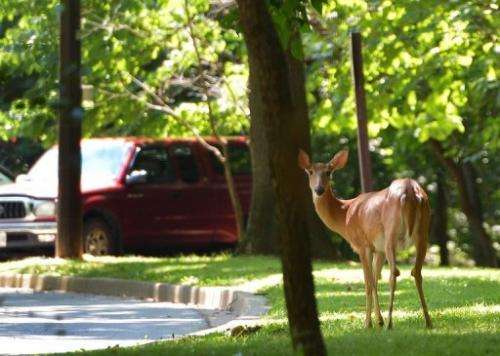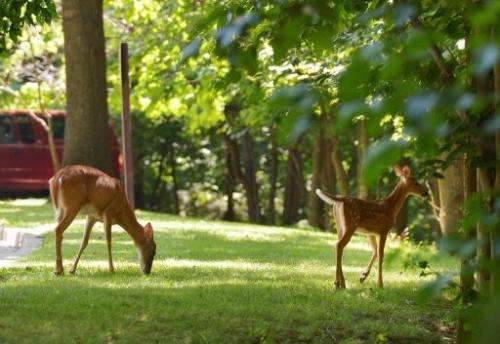Too cute to kill? US split on suburban deer

Seconds after Mike Braun spotted the deer in his headlights his six-day-old car had $8,000 worth of damage, including a punctured radiator.
"It could have been a lot worse," said the consultant, who lives in the US capital, as he recalled his drive home from the airport late one night in June.
Luckily, Braun wasn't hurt and the deer darted off.
Close calls such as this highlight the tension between humans and their hoofed neighbors.
While beloved by many, Bambi is blamed not only for accidents—1.2 million between July 2011 and June 2012 according to one estimate—but also a loss of vegetation and even the spread of disease in suburban America.
Amid safety qualms about shooting rifles in residential areas, communities are getting creative and turning to bow hunting and even birth control to keep down deer numbers in towns and suburbs.
Near Washington, some homeowners irked by deer lunching on their landscaping or worried about Lyme disease—transmitted by the deer tick—call on archery experts to carry out culls.
Occasionally in camouflage, hunters use portable tree stands and modern equipment that is a far cry from the traditional Robin Hood-type bows and arrows, said Gregg Brown, spokesman for Suburban Whitetail Management of Northern Virginia.
Shots are taken from an elevated position and at close range, sometimes after an hours-long wait.
"It is proven to be very safe," Brown said.

But critics argue that deer can die a slow and painful death and that arrows might go astray, endangering people and pets.
"I think the question that should be asked is do we have to kill? Why can't we find better solutions that keep those deer alive?" said Anja Heister of In Defense of Animals.
Her California-based group, together with others, took legal action against a decision to shoot deer in Rock Creek Park, Washington's green lung. Twenty were culled in March, with follow-up planned for the fall.
"Over the last 20 years, the park's white-tailed deer population has grown so large that the deer are eating nearly all tree seedlings, preventing forest sustainability," the National Park Service said.
The activists, who recently turned in a legal petition with what they called a new expert analysis that casts "serious doubt" on justification for the killings, point to birth control as a humane way for handling such situations.
"My preference would be to let those animals be," Heister said of culls in general. But "the next best thing in my mind is, yes, contraception."
Near New York City, a community is preparing to give it a try.
"If it works it would be great for us because we will finally have a tool that will not prompt a reaction out of the public - a negative reaction," said Hastings-on-Hudson Mayor Peter Swiderski.
"It will be humane and it will also be a terrific alternative for literally the thousands other communities like ours that also face this. We are not alone."
The village of two square miles (five square kilometers) has roughly 8,000 residents - and somewhere between 70 and 100 deer, he said.
These, he added, cause about a dozen car crashes a year and the disappearance of underbrush.
"It used to be if a tree fell down, there were saplings to take its place," he said. But now, "other than some raspberry bushes and weeds, nothing else much survives."
The immunocontraceptive—consisting of porcine zona pellucida from pig ovaries—is administered as a vaccine, said Allen Rutberg, director of Tufts University's Center for Animals and Public Policy, who is working with Swiderski.
Around since the 1970s, it was first developed for potential human use, he added. While it didn't work out for that purpose, it has proven effective on deer in different locations, as well as on other animals.
"What we are looking at is a technique that people in the suburbs can be comfortable with," he said.
Braun, reflecting on his scare, suggested the best way to deal with the deer dilemma was to keep a cool head and consider all the facts.
"You have to sit down and figure out without the emotion what's actually going to work, what's going to not ... put the deer in any unnecessary pain," he said.
© 2013 AFP
















